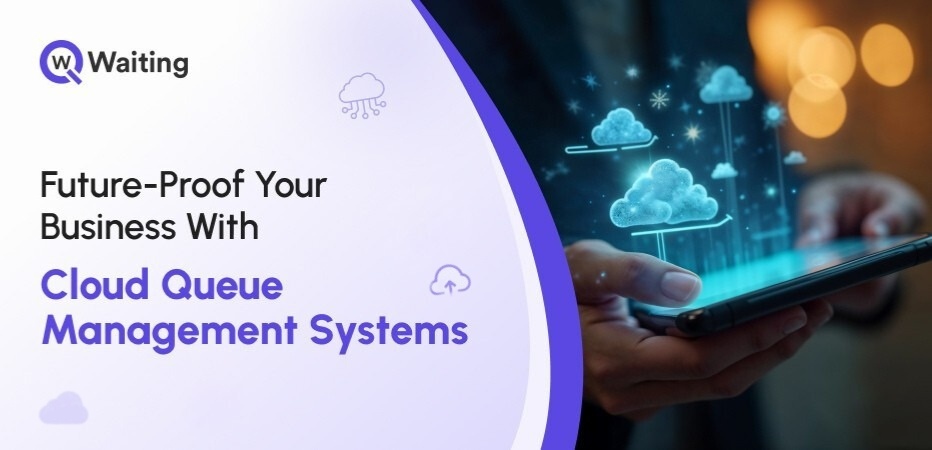
Imagine this: It’s Monday morning, your customers are piling up, and your front desk looks like a scene from 2010. Meanwhile, other businesses are using intelligent queue management systems to serve their customers.
Across industries, businesses are replacing outdated manual systems with cloud-powered queue management. These softwares delivers fast, seamless, and personalized services.
In 2025, customers expect instant and hassle-free services, and you should not need a full IT department or heavy software to deliver them. That is why smart brands are switching to a cloud queue management system that reduces wait times, improves staff efficiency, and strengthens customer relationships. With a cloud-based platform, you can track real-time customer footfall, control operations from anywhere, and keep customers happy with a single centralized dashboard.
In this blog, we will discuss how traditional queues reduce work efficiency and how you can switch to cloud software smoothly without disrupting your current workflow.
Traditional Queues Are Killing Efficiency! Here’s Why You Can’t Afford to Ignore It
Customer expectations have shifted dramatically. Relying on traditional queuing systems not only frustrates visitors but also drains staff productivity and costs you valuable revenue. Here’s how:
1. The Real Cost of Manual and On‑Premise Queue Systems
Relying on local server-based queue software or traditional queuing methods can lead to:
- Lost productivity – Staff spend unnecessary time managing lines, handling check-ins, and answering repetitive questions instead of focusing on delivering great service.
- Customer churn – According to Gradient Labs (May 2025), 75% of customers cite long waiting times as a major service frustration. Due to this, customers leave and never return, which resulting in significant revenue loss.
- Operational errors – Manual record-keeping is prone to mistakes. Correcting these errors wastes valuable time, disrupts workflows, and slows down service delivery.
2. Signs Your Existing Queue System is Failing
Outdated queue systems may not break overnight, but their hidden flaws can slowly erode efficiency, customer satisfaction, and compliance. Watch for these warning signs:
- Long wait lines: You may notice long customer wait times during peak hours, even when your staff members are working and serving customers efficiently.
- Overwhelmed staff: Manual data entry and repetitive queries consume valuable time, frustrate customers, and push staff toward burnout.
- Compliance risks: Research shows that 60% of businesses encounter issues during audits. Inaccurate or incomplete records can cause security breaches and even lead to legal penalties.
3. Why Your Competitors Already Switched to Cloud Queue Software
Gartner reports (November 2024) stated that by 2026, 75 % organizations will prioritize cloud-based software for their digital transformations.
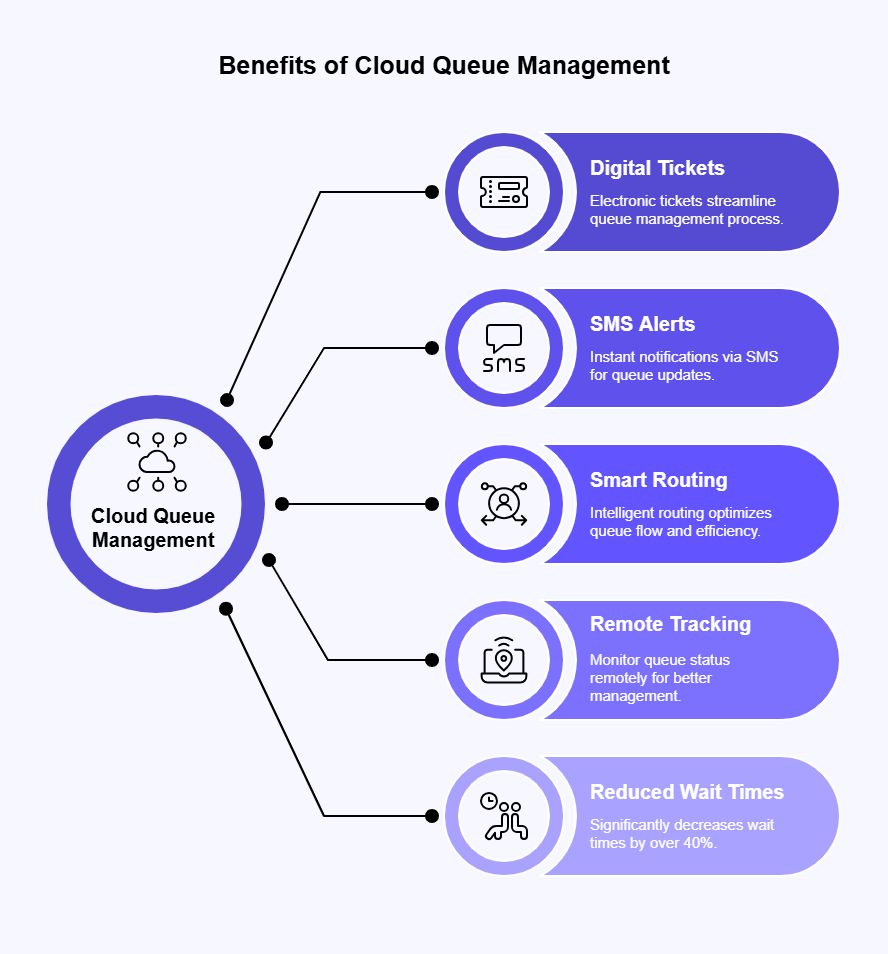
There are several benefits of cloud queue management, like:
- Businesses are shifting to cloud-first platforms with digital tickets, SMS alerts, and smart routing to stay competitive.
- Track your business growth remotely using laptops or even smartphones.
- Cloud systems have helped many businesses reduce their customer wait times by over 40%.
Cloud queuing helps your business grow and deliver fast, stress-free customer service.
Here’s what successful businesses say after experiencing cloud transformation:
“Netflix, a widely usManual ed OTT platform, completed its cloud migration in 2016 and has experienced zero service outages caused by hardware or server failures since moving to the cloud.”
Cloud Queue Management vs. Traditional Queuing: What Every Modern Business Must Know
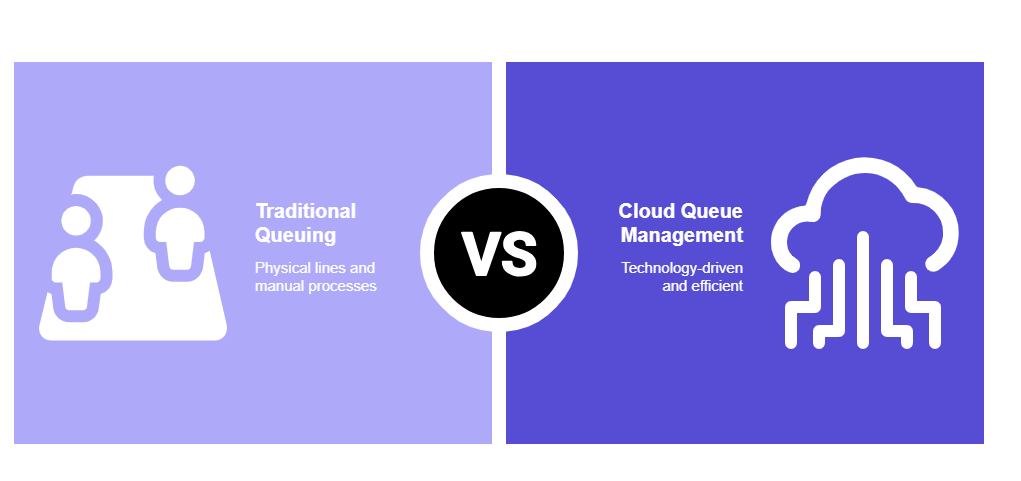
Let’s imagine you run a busy retail store. Staff members are busy assisting customers, and the line is growing. Yet you’re still relying on outdated methods to manage checkouts and other operations. Before long, you lose track of who’s next, customers get frustrated, and service slows to a crawl.
To prevent these bottlenecks, more businesses are switching to smart cloud-based queue management software that lets them monitor performance in real time — from anywhere. But before making the switch, it’s essential to understand exactly what a cloud queuing solution is and how it can transform your operations, boost efficiency, and improve customer satisfaction.
How Cloud-Based Software Helps Businesses Scale and Improve Efficiency?
Cloud queue management systems are being adopted across industries because they deliver unmatched flexibility, speed, and cost efficiency.

1. Flexibility, Speed, and Control
- Monitor and manage queues 24/7 from anywhere.
- No heavy machinery or in-house servers required.
- Automatic data backups ensure nothing is lost.
- Automatic updates, no IT help needed..
2. Cost Advantage: Cloud vs. On-Premise Solutions
- Minimal setup costs with no need for bulky hardware or dedicated servers.
- Simple monthly subscription pricing.
- No need to hire specialized tech staff for maintenance.
- Highly scalable, easily add new locations or services as your business grows.
Here’s a clear, side-by-side comparison of cloud-based vs. traditional queue systems to help you make the right choice faster.
| Features | Traditional Queue System | Cloud-based queue system |
| Setup time | Weeks to months | Days or less |
| Up-front cost | High | Low |
| Maintenance | Manual, costly | Automated, included |
| Scalability | Rigid | Instantly scalable |
| Data access | Local-only | Global, real-time |
Cloud vs. Traditional Queue Systems Real-World Success Story
In 2010, the Land Transport Authority (LTA) of Fiji faced severe queuing issues that slowed citizen services. By adopting SMARTQUEUE’s cloud-based system, they enabled real-time data access, digital alerts, and remote check-ins. This transformation streamlined operations, reduced wait times, and built a scalable foundation for future growth.
Many government offices around the globe are adapting digital queuing solutions to modernize citizen services. Want to learn more? Read: How the Digital Queue System Transforms Public Service.
How Cloud Queue Management Drives Real-Time Visibility and Business Growth
To succeed and stay ahead of competitors, businesses need to adapt to new technologies to simplify their operations and provide a better customer service experience.
1. Boost customer experience
Cloud software is gaining prominence in the industry as this software is proven to:
-
Improve conversions and customer experience
Easily integrates with existing business software. This means you can simplify checkout payments by connecting it with multiple payment channels like PayPal, credit cards, or netbanking to ensure a smooth checkout.
-
SMS Alerts to reduce no-shows
A Qless customer survey revealed that using the cloud-based SMS Queuing feature, customer wait times dropped by 97%.

The system can send automatic message alerts to keep customers updated on their wait times. This keeps everyone informed and in sync and reduces the chances of no shows.
2. Allows Centralized Management Across Multiple Locations
For business owners, it can sometimes be difficult to manage operations across multiple branches. With cloud software, businesses can:
-
Real-Time Visibility and Control
According to a 2024 feature on TMCnet, cloud-based queuing solutions empower organizations to manage queue operations across all branches from a central dashboard, eliminating the need for manual intervention at each location. This boosts efficiency and cuts response times when demand spikes.
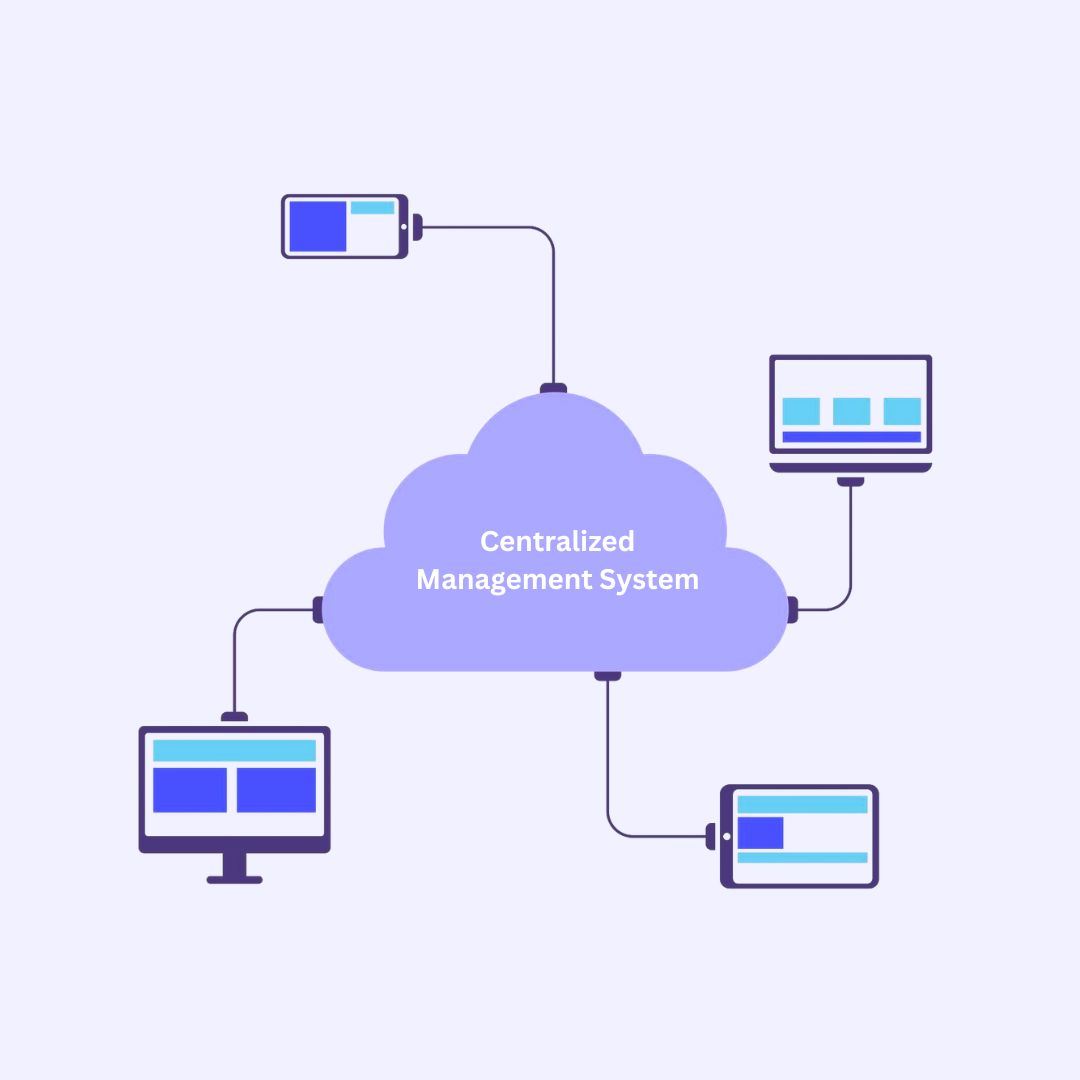
-
Standardized Customer Experience
With cloud-based systems, you can ensure uniform queue rules, notifications, and service workflows across all branches, creating a consistent, high-quality experience every time.
3. Better Reporting & Data-Driven Decisions
Data reports based on customers’ past experience can help businesses grow and fix bottlenecks. The software generates real-time data reports that help businesses to:
-
Make smarter decisions
Cloud systems store and organize data based on customers’ past visits, making it easy to identify patterns and plan resources effectively. Use data to staff smarter or expand services, based on facts, not guesses.
-
Tracking Real-Time Performance Insights
With a cloud queue management system, you get access to real-time dashboards that track visitor flow, peak hours, average wait times, and service performance, all in one place. This helps you take immediate action instead of guessing what’s going wrong.
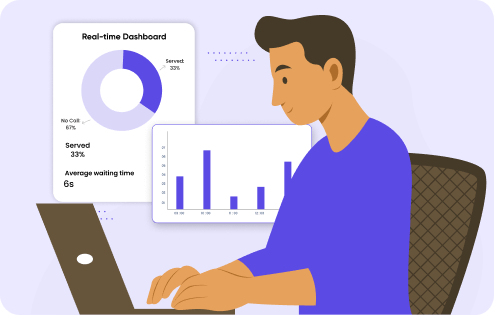
Check out our post on 10 benefits of using cloud-based queue management software to know more about how queue systems streamline customer journeys.
4. Easy Compliance, Security, and Remote Access
Cloud systems store customer data securely, so there is no chance of data theft. Here’s how remote data access using a cloud-based queue system is beneficial:
-
Remote access
Persons with authorized access can securely log in and track customer flow, staff performance, and system usage. With secure encryption and multi-factor authentication, executives can control who accesses what, minimizing data breaches and maximizing visibility.
-
ISO Certified and GDPR Compliant for smooth compliance
According to the sources, companies aligning with standards like ISO 27001 or GDPR experience 33% fewer security breaches, making their systems more reliable during audits.

Making the Move: How to Transition Without Disruption
Making a shift from the old queuing system to an advanced cloud system can be a bit tough for some people. Here’s how you can seamlessly adapt to these latest technologies, without making many alterations to your existing business operations.
Step-by-Step Migration Plan for Enterprises
You don’t need to take a off from your business operations or hire IT experts to set up the software. The move from your old system to a cloud queue solution can be done in a few easy steps:
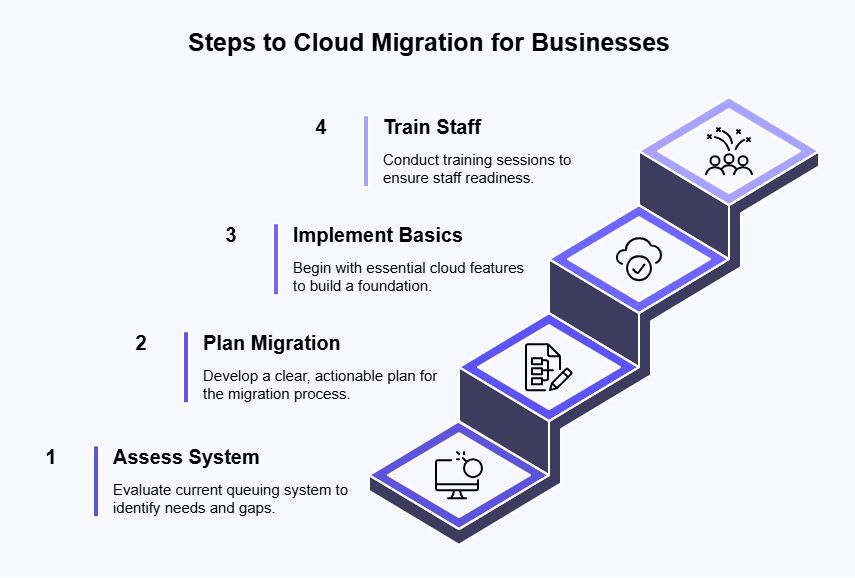
1. Assess Your Current System:
- Run a complete audit on the current software your business uses.
- List the problems you are facing, like: what is slow, what breaks often, and what frustrates your staff and customers.
2. Make a Simple Plan:
- Look for the industry advancements or additional integrations you want in your software.
- This helps you avoid paying for things you don’t need.
3. Start with the basics:
- Start with a pilot plan for your business. If it suits, then think of scaling it. This will help you test your software for a better understanding.
- Your new provider will help move all customer data, settings, and staff accounts without losing anything to ensure a smooth experience.
4. Staff Training Without the Tech Jargon:
Some employees may oppose the tech-savvy software because they may think it is hard to operate. To ensure proper coordination, choose a provider who offers quick and clear training.
How Cloud Queue Management Delivers Measurable ROI in 90 Days
Switching to a cloud queue management system can deliver noticeable results in as little as three months. Here’s what most businesses experience within the first 90 days:
-
Reduced Wait Times:
Customers get served faster, leading to higher footfall, shorter lines, and more repeat visits.
-
Improved Customer Satisfaction (CSAT) Scores
Happier customers leave positive reviews, provide valuable feedback, and recommend your business to others.
-
Fewer Dropouts and No-Shows
Automated SMS alerts and smart scheduling reduce the chances of customers leaving or missing their turn.
-
Smarter Staffing Decisions
Real-time reports help you allocate staff where they are needed most, reducing unnecessary labor costs.
Real-World Impact: Ram Clinics, Saudi Arabia
By adopting Qwaiting’s cloud queue system across 21+ branches, Ram Clinics reduced patient wait times by 20 minutes, boosted staff efficiency, automated check-ins with self-service kiosks and digital signage, and significantly improved the overall patient experience.
The Right Time to Switch is Now
In 2025, businesses that still depend on slow, outdated systems aren’t just behind the competition; they’re losing time, money, and credibility. While you’re struggling with long queues, staff overload, and confusing records, your competitors are using cloud-based queue software to run smooth, fast, and error-free operations from anywhere in the world.
With a smart cloud queue system, you can:
- Manage all branches from one place
- Cut down long lines and speed up service
- Make better decisions with real-time data
- Keep customer information secure and stay compliant
The best part? You don’t need a full IT team or big budget to make the switch. The setup is smooth, support is built-in, and you can start seeing results in as little as 90 days.
Thousands of businesses are already benefiting from the Qwaiting’s smart cloud queue management.
Take control now! Talk to our expert team or start your 14-day free trial today, and give your team and customers the seamless experience they deserve.
FAQ’s
Will I lose any customer data when switching to the cloud?
No. Qwaiting guarantees a smooth transition by securely migrating all your existing data without loss, allowing you to maintain operations without starting from scratch.
How can this system help me scale across multiple locations?
Qwaiting’s AI-powered cloud platform lets you manage all branches from a single dashboard. Easily manage queues, track staff performance, and oversee business operations in real time, no matter how many locations you run.
Which industries can benefit the most from a cloud queue management system?
Healthcare providers, banks, government offices, retailers, educational institutions, and airports have all seen significant improvements in efficiency and service quality with Qwaiting.
Does it integrate with my existing systems?
Yes. Qwaiting offers API integrations and compatibility with popular CRM, ERP, and notification tools so you can connect it seamlessly to your current tech stack.
How quickly can I get started?
Implementation can take as little as a few days. Our team provides onboarding support, training, and configuration to ensure a smooth launch.
Is training required for my staff?
Minimal training is needed. Qwaiting’s intuitive interface makes it easy for staff to get up to speed quickly.
